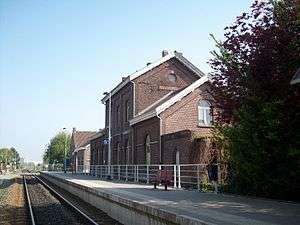Waarschoot railway station
Waarschoot is a railway station in Waarschoot, East Flanders, Belgium. The station opened on 25 June 1861 on the Line 58. The train services are operated by NMBS/SNCB.
Waarschoot | |
|---|---|
 | |
| Location | Stationsplein, Waarschoot |
| Coordinates | 51°09′17″N 3°36′52″E |
| Owned by | National Railway Company of Belgium |
| Line(s) | 58 |
| Platforms | 1 |
| Tracks | 1 |
| Other information | |
| Station code | LWT |
| History | |
| Opened | 25 June 1861 |
| Rebuilt | 29 May 1988 |
| Traffic | |
| Passengers (2009) | 52572 |
Train services
The station is served by the following service(s):
- Local services (L-05) Eeklo - Ghent - Oudenaarde - Ronse
- Local services (L-05) Eeklo - Ghent - Oudenaarde - Kortrijk (weekdays)
| Preceding station | Following station | |||
|---|---|---|---|---|
Terminus | L 05 weekdays | |||
Terminus | L 05 weekends | toward Ronse |
gollark: POST data isn't in the URL though, it's sent as the body.
gollark: The reason they *do* is probably just consistency with other methods (it would be very annoying if they worked very differently to GET routing-wise) and so requests can be routed to the right handler more easily.
gollark: <@498244879894315027> Why wouldn't (shouldn't?) they have a URL?
gollark: They do have to spin pretty fast. There are sealed helium ones now.
gollark: > The HDD's spindle system relies on air density inside the disk enclosure to support the heads at their proper flying height while the disk rotates. HDDs require a certain range of air densities to operate properly. The connection to the external environment and density occurs through a small hole in the enclosure (about 0.5 mm in breadth), usually with a filter on the inside (the breather filter).[124] If the air density is too low, then there is not enough lift for the flying head, so the head gets too close to the disk, and there is a risk of head crashes and data loss. Specially manufactured sealed and pressurized disks are needed for reliable high-altitude operation, above about 3,000 m (9,800 ft).[125] Modern disks include temperature sensors and adjust their operation to the operating environment. Breather holes can be seen on all disk drives – they usually have a sticker next to them, warning the user not to cover the holes. The air inside the operating drive is constantly moving too, being swept in motion by friction with the spinning platters. This air passes through an internal recirculation (or "recirc") filter to remove any leftover contaminants from manufacture, any particles or chemicals that may have somehow entered the enclosure, and any particles or outgassing generated internally in normal operation. Very high humidity present for extended periods of time can corrode the heads and platters. https://en.wikipedia.org/wiki/Hard_disk_drive#Integrity
References
This article is issued from Wikipedia. The text is licensed under Creative Commons - Attribution - Sharealike. Additional terms may apply for the media files.